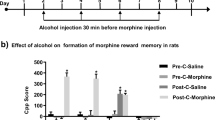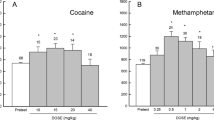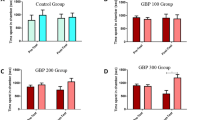Abstract
Rationale
Chronic exposure to drugs of abuse alters neural processes that normally promote learning and memory. A context that is repeatedly paired with reinforcing drugs will acquire secondary reinforcing properties (conditioned reward). However, the effects of conditioned reward on spatial learning are unknown.
Objective
Using the conditioned place preference procedure and Morris water maze task, we examined the role of conditioned reward or aversion in spatial learning.
Materials and methods
Groups of rats acquired morphine (10 mg/kg), cocaine (10 mg/kg), or oral sucrose (15%) conditioned place preference (CPP). Another group of morphine-dependent rats acquired conditioned place aversion (CPA) to a context paired with precipitated opiate withdrawal induced by naloxone injections (1 mg/kg). To examine the role of conditioned reward or aversion in spatial learning, rats were then exposed to the previously morphine-, cocaine-, sucrose- or naloxone-paired context for 10 min before training of spatial learning in the Morris water maze.
Results
Exposure to the morphine- or cocaine-paired but not the sucrose- or the naloxone-paired context decreased the latency to find the platform in the Morris water maze test.
Conclusions
Our results provide the first evidence that conditioned drug reward promotes spatial learning. We speculate that this enhancement of spatial learning by the drug-paired context may promote contextual-cue-induced relapse to drug taking by facilitating exploratory drug-seeking behaviors.


Similar content being viewed by others
References
Aldavert-Vera L, Segura-Torres P, Costa-Miserachs D, Morgado-Bernal I (1996) Shuttle-box memory facilitation by posttraining intracranial self-stimulation: differential effects in rats with high and low basic conditioning levels. Behav Neurosci 110:346–352
Alderson HL, Jenkins TA, Kozak R, Latimer MP, Winn P (2001) The effects of excitotoxic lesions of the pedunculopontine tegmental nucleus on conditioned place preference to 4%, 12% and 20% sucrose solutions. Brain Res Bull 56:599–605
Badiani A, Oates MM, Robinson TE (2000) Modulation of morphine sensitization in the rat by contextual stimuli. Psychopharmacology (Berl) 151:273–82
Bardo MT, Bevins RA (2000) Conditioned place preference: what does it add to our preclinical understanding of drug reward. Psychopharmacology 153:31–43
Bardo MT, Rowlett JK, Harris MJ (1995) Conditioned place preference using opiate and stimulant drugs: a meta-analysis. Neurosci Biobehav Rev 19:39–51
Beninger RJ, Gerdjikov T (2004) The role of signaling molecules in reward-related incentive learning. Neurotox Res 6:91–104
Berke JD (2003) Learning and memory mechanisms involved in compulsive drug use and relapse. Methods Mol Med 79:75–101
Bespalov A, Zvartau EE (1992) Conditioned-reflex activation of electrical self-stimulation of the brain: a model of situational craving for narcotics. Zhurnal Vysshei Nervnoi Deiatelnosti Imeni IP Pavlova 42:759–763
Crombag HS, Badiani A, Maren S, Robinson TE (2000) The role of contextual versus discrete drug-associated cues in promoting the induction of psychomotor sensitization to intravenous amphetamine. Behav Brain Res 116:1–22
Delamater AR, Sclafani A, Bodnar RJ (2000) Pharmacology of sucrose-reinforced place-preference conditioning: effects of naltrexone. Pharmacol Biochem Behav 65:697–704
Ehrman RN, Robbins SJ, Childress AR, O'Brien CP (1992) Conditioned responses to cocaine-related stimuli in cocaine abuse patients. Psychopharmacology 107:523–529
Everitt BJ, Robbins TW (2005) Neural systems of reinforcement for drug addiction: from actions to habits to compulsion. Nat Neurosci 8:1481–1489
Foster TC, Castro CA, McNaughton BL (1989) Spatial selectivity of rat hippocampal neurons: dependence on preparedness for movement. Science 244:1580–1582
Gawin FH, Kleber HD (1986) Abstinence symptomatology and psychiatric diagnosis in cocaine abusers. Clinical observations. Arch Gen Psychiatry 43:107–113
Hammad H, Wagner JJ (2006) Dopamine-mediated disinhibition in the CA1 region of rat hippocampus via D3 receptor activation. J Pharmacol Exp Ther 316:113–120
Harmer CJ, Phillips GD (1998) Enhanced appetitive conditioning following repeated pretreatment with d- amphetamine. Behav Pharmacol 9:299–308
Harmer CJ, Phillips GD (1999) Enhanced conditioned inhibition following repeated pretreatment with d-amphetamine. Psychopharmacology (Berl) 142:120–131
Harris GC, Wimmer M, Byrne R, Aston-Jones G (2004) Glutamate-associated plasticity in the ventral tegmental area is necessary for conditioning environmental stimuli with morphine. Neuroscience 129:841–847
Hyman SE (2005) Addiction: a disease of learning and memory. Am J Psychiatry 162:1414–22
Hyman SE, Malenka RC, Nestler EJ (2006) Neural mechanisms of addiction: the role of reward-related learning and memory. Annu Rev Neurosci 29:565–598
Itzhak Y, Martin JL (2002) Cocaine-induced conditioned place preference in mice: induction, extinction and reinstatement by related psychostimulants. Neuropsychopharmacology 26:130–134
Jentsch JD, Taylor JR (1999) Impulsivity resulting from frontostriatal dysfunction in drug abuse: implications for the control of behavior by reward-related stimuli. Psychopharamacology 146:373–390
Kenny PJ, Koob GF, Markou A (2003) Conditioned facilitation of brain reward function after repeated cocaine administration. Behav Neurosci 117:1103–1107
Koya E, Spijker S, Voorn P, Binnekade R, Schmidt ED, Schoffelmeer AN, De Vries TJ, Smit AB (2006) Enhanced cortical and accumbal molecular reactivity associated with conditioned heroin, but not sucrose-seeking behaviour. J Neurochem 98:905–915
Lu L, Chen H, Su W, Ge X, Yue W, Su F, Ma L (2005) Role of withdrawal in reinstatement of morphine-conditioned place preference. Psychopharmacology (Berl) 181:90–100
Lu L, Liu D, Ceng X (2001) Corticotropin-releasing factor receptor type 1 mediates stress-induced relapse to cocaine-conditioned place preference in rats. Eur J Pharmacol 415:203–208
Lu L, Liu D, Ceng X, Ma L (2000) Differential roles of corticotropin-releasing factor receptor subtypes 1 and 2 in opiate withdrawal and in relapse to opiate dependence. Eur J Neurosci 12:4398–4404
McNaughton BL, Barnes CA, O'Keefe J (1983) The contributions of position, direction, and velocity to single unit activity in the hippocampus of freely-moving rats. Exp Brain Res 52:41–49
McQuiston AR, Saggau P (2003) Mu-opioid receptors facilitate the propagation of excitatory activity in rat hippocampal area CA1 by disinhibition of all anatomical layers. J Neurophysiol 90:1936–1948
Meyers RA, Zavala AR, Speer CM, Neisewander JL (2006) Dorsal hippocampus inhibition disrupts acquisition and expression, but not consolidation, of cocaine conditioned place preference. Behav Neurosci 120:401–412
Milekic MH, Brown SD, Castellini C, Alberini CM (2006) Persistent disruption of an established morphine conditioned place preference. J Neurosci 26:3010–3020
Morris RG, Anderson E, Lynch GS, Baudry M (1986) Selective impairment of learning and blockade of long-term potentiation by an N-methyl-D-aspartate receptor antagonist, AP5. Nature 319:774–776
Morris RG, Garrud P, Rawlins JN, O'Keefe J (1982) Place navigation impaired in rats with hippocampal lesions. Nature 297:681–683
Morris RG, Schenk F, Tweedie F, Jarrard LE (1990) Ibotenate lesions of hippocampus and/or subiculum: dissociating components of allocentric spatial learning. Eur J Neurosci 2:1016–1028
Moser E, Moser MB, Andersen P (1993) Spatial learning impairment parallels the magnitude of dorsal hippocampal lesions, but is hardly present following ventral lesions. J Neurosci 13:3916–3925
Mucha RF (1987) Is the motivational effect of opiate withdrawal reflected by common somatic indices of precipitated withdrawal? A place conditioning study in the rat. Brain Res 418:214–220
Neumaier JF, Chavkin C (1986) Opioid receptor activity in the dentate region of the rat hippocampus. NIDA Res Monogr 75:101–104
O’Keefe J (1983) Two spatial systems in the rat brain—implications for the neural basis of learning and memory. Prog Brain Res 58:453–464
Olson VG, Zabetian CP, Bolanos CA, Edwards S, Barrot M, Eisch AJ, Hughes T, Self DW, Neve RL, Nestler EJ (2005) Regulation of drug reward by cAMP response element-binding protein: evidence for two functionally distinct subregions of the ventral tegmental area. J Neurosci 25:5553–5562
Phillips GD, Setzu E, Hitchcott PK (2003) Facilitation of appetitive Pavlovian conditioning by d-amphetamine in the shell, but not the core, of the nucleus accumbens. Behav Neurosci 117:675–684
Robinson TE, Berridge KC (1993) The neural basis of drug craving: An incentive-sensitization theory of addiction. Brain Res Rev 18:247–291
Roma PG, Riley AL (2005) Apparatus bias and the use of light and texture in place conditioning. Pharmacol Biochem Behav 82:163–169
Salem A, Hope W (1997) Effect of adenosine receptor agonists and antagonists on the expression of opiate withdrawal in rats. Pharmacol Biochem Behav 57:671–679
Schechter MD, Calcagnetti DJ (1993) Trends in place preference conditioning with a cross-indexed bibliography; 1957–1991. Neurosci Biobehav Rev 17:21–41
Schoenbaum G, Roesch MR, Stalnaker TA (2006) Orbitofrontal cortex, decision-making and drug addiction. Trends Neurosci 29:116–124
Segura-Torres P, Capdevila-Ortis L, Marti-Nicolovius M, Morgado-Bernal I (1988) Improvement of shuttle-box learning with pre- and post-trial intracranial self-stimulation in rats. Behav Brain Res 29:111–117
Segura-Torres P, Portell-Cortes I, Morgado-Bernal I (1991) Improvement of shuttle-box avoidance with post-training intracranial self-stimulation, in rats: a parametric study. Behav Brain Res 42:161–167
Self DW (2004) Regulation of drug-taking and -seeking behaviors by neuroadaptations in the mesolimbic dopamine system. Neuropharmacology 47(Suppl 1):242–255
Stewart J (2004) Pathways to relapse: factors controlling the reinitiation of drug seeking after abstinence. Nebr Symp Motiv 50:197–234
Taylor JR, Horger BA (1999) Enhanced responding for conditioned reward produced by intra-accumbens amphetamine is potentiated after cocaine sensitization. Psychopharmacology 142:31–40
Taylor JR, Jentsch JD (2001) Repeated intermittent administration of psychomotor stimulant drugs alters the acquisition of Pavlovian approach behavior in rats: differential effects of cocaine, d-amphetamine and 3,4-methylenedioxymethamphetamine (“Ecstasy”). Biol Psychiatry 50:137–143
Taylor JR, Robbins TW (1984) Enhanced behavioural control by conditioned reinforcers following microinjections of d-amphetamine into the nucleus accumbens. Psychopharmacology 84:405–412
Tzschentke TM (1998) Measuring reward with the conditioned place preference paradigm: a comprehensive review of drug effects, recent progress and new issues. Prog Neurobiol 56:613–672
Valjent E, Corbille AG, Bertran-Gonzalez J, Herve D, Girault JA (2006) Inhibition of ERK pathway or protein synthesis during reexposure to drugs of abuse erases previously learned place preference. Proc Natl Acad Sci U S A 103:2932–2937
Wang J, Fang Q, Liu Z, Lu L (2006) Region-specific effects of brain corticotropin-releasing factor receptor type 1 blockade on footshock-stress- or drug-priming-induced reinstatement of morphine conditioned place preference in rats. Psychopharmacology 185:19–28
Watanabe T, Nakagawa T, Yamamoto R, Maeda A, Minami M, Satoh M (2002) Involvement of glutamate receptors within the central nucleus of the amygdala in naloxone-precipitated morphine withdrawal-induced conditioned place aversion in rats. Jpn J Pharmacol 88:399–406
Watanabe T, Nakagawa T, Yamamoto R, Maeda A, Minami M, Satoh M (2003) Involvement of noradrenergic system within the central nucleus of the amygdala in naloxone-precipitated morphine withdrawal-induced conditioned place aversion in rats. Psychopharmacology (Berl) 170:80–88
White NM (1996) Addictive drugs as reinforcers: multiple partial actions on memory systems. Addiction 91:921–949 discussion 951–965)
Wyvell CL, Berridge KC (2000) Intra-accumbens amphetamine increases the conditioned incentive salience of sucrose reward: enhancement of reward “wanting” without enhanced “liking” or response reinforcement. J Neurosci 20:8122–8130
Wyvell CL, Berridge KC (2001) Incentive sensitization by previous amphetamine exposure: increased cue- triggered “wanting” for sucrose reward. J Neurosci 21:7831–7840
Yang Y, Zheng X, Wang Y, Cao J, Dong Z, Cai J, Sui N, Xu L (2004) Stress enables synaptic depression in CA1 synapses by acute and chronic morphine: possible mechanisms for corticosterone on opiate addiction. J Neurosci 24:2412–2420
Yoganarasimha D, Shankaranarayana Rao BS, Raju TR, Meti BL (1998) Facilitation of acquisition and performance of operant and spatial learning tasks in self-stimulation experienced rats. Behav Neurosci 112:725–729
Zhai J, Wieland SJ, Sessler FM (1997) Chronic cocaine intoxication alters hippocampal sodium channel function. Neurosci Lett 229:121–124
Acknowledgments
This work was supported in part by the grants from Intramural Research Program of National Institute on Drug Abuse, NIH, USA, the 985 talent program of Peking University (nos. 985-2-046-121 and 985-2-027-39), the New Century Talent Scientist Grant of Ministry of Education, and the National Natural Science Foundation of China (nos. 30570576, 30670713, and 30611120528). We would like to thank Dr. Yavin Shaham for his help in preparation of this manuscript.
Author information
Authors and Affiliations
Corresponding author
Rights and permissions
About this article
Cite this article
Zhai, Hf., Zhang, ZY., Zhao, M. et al. Conditioned drug reward enhances subsequent spatial learning and memory in rats. Psychopharmacology 195, 193–201 (2007). https://doi.org/10.1007/s00213-007-0893-x
Received:
Accepted:
Published:
Issue Date:
DOI: https://doi.org/10.1007/s00213-007-0893-x




